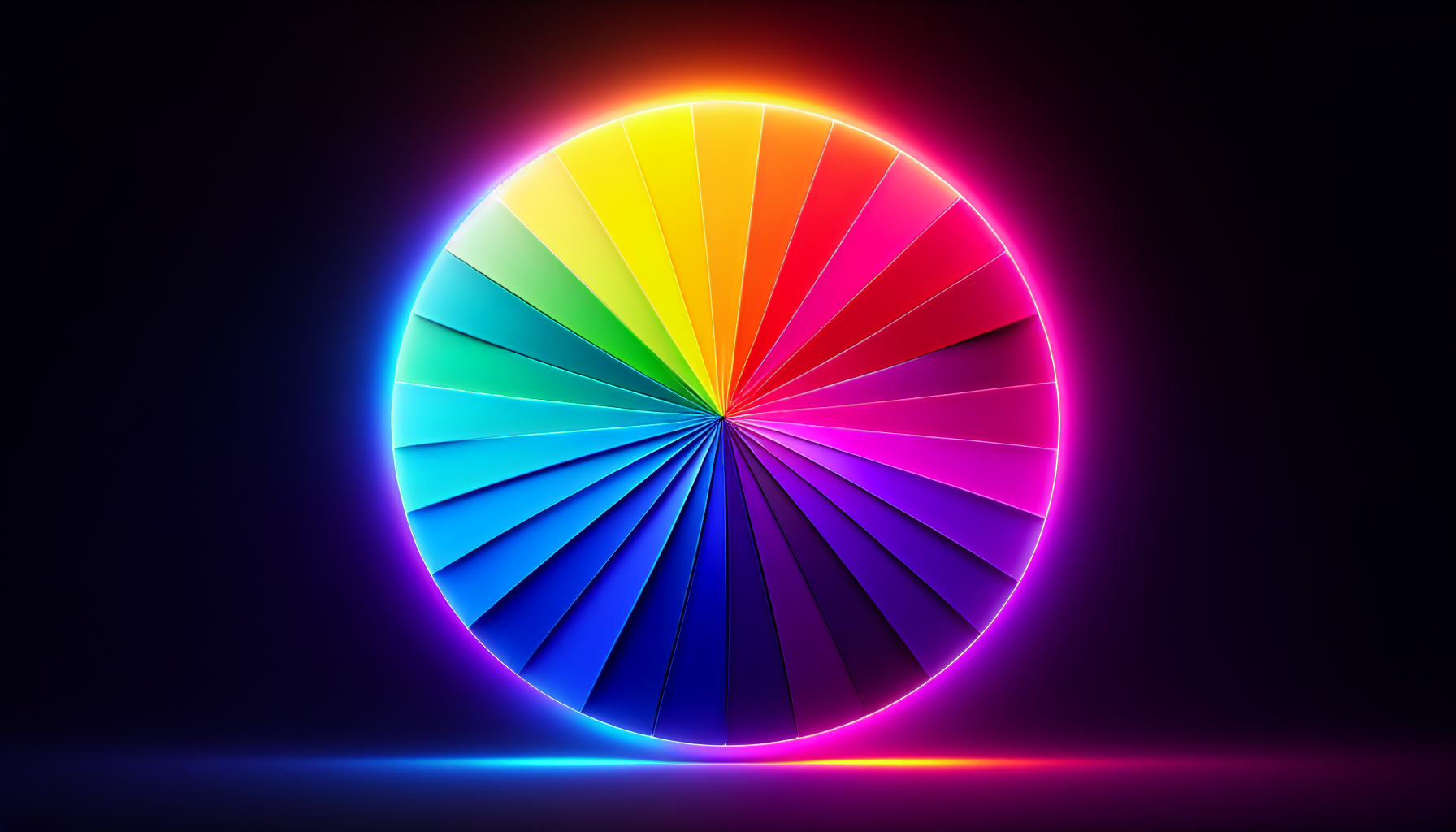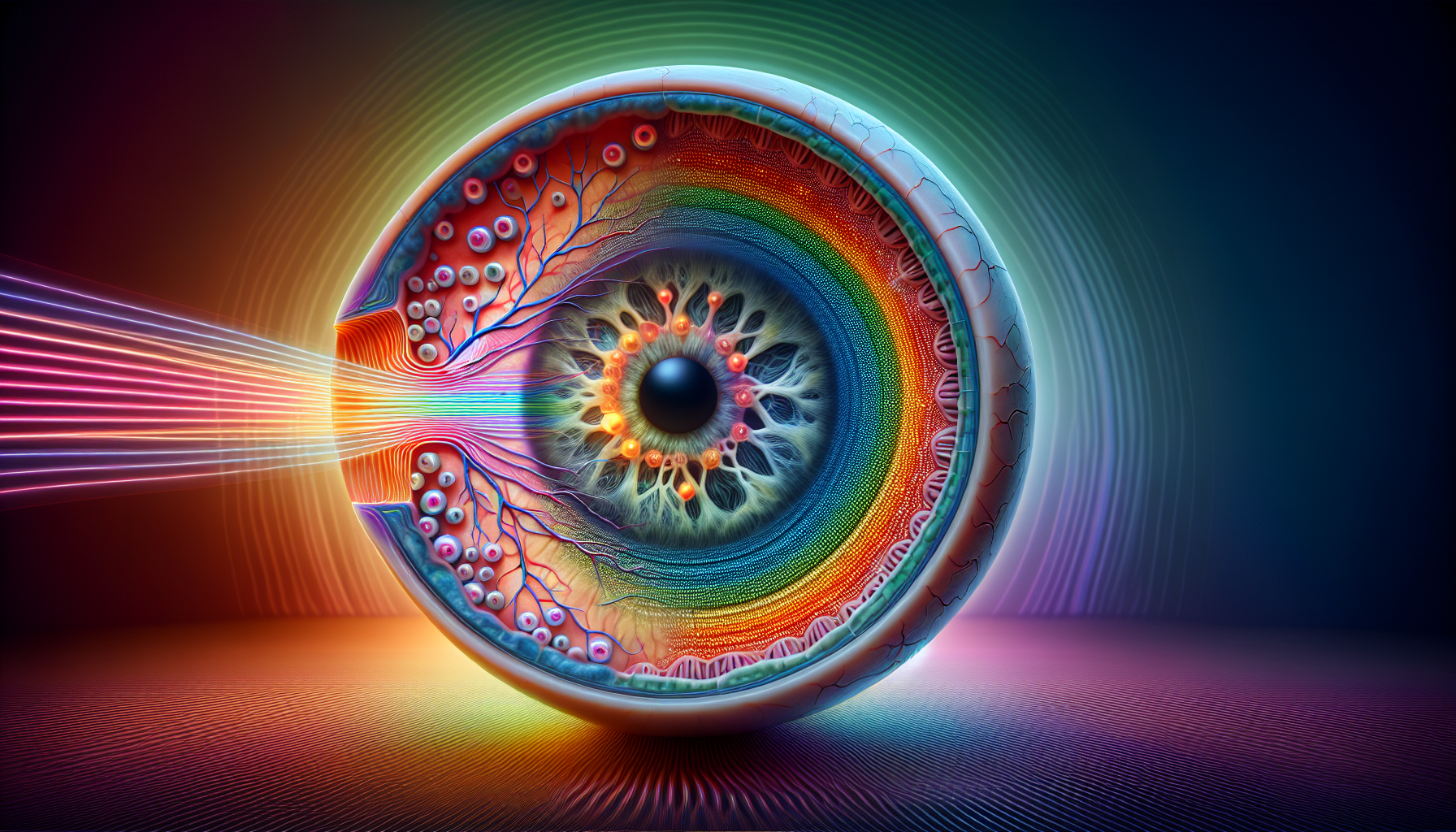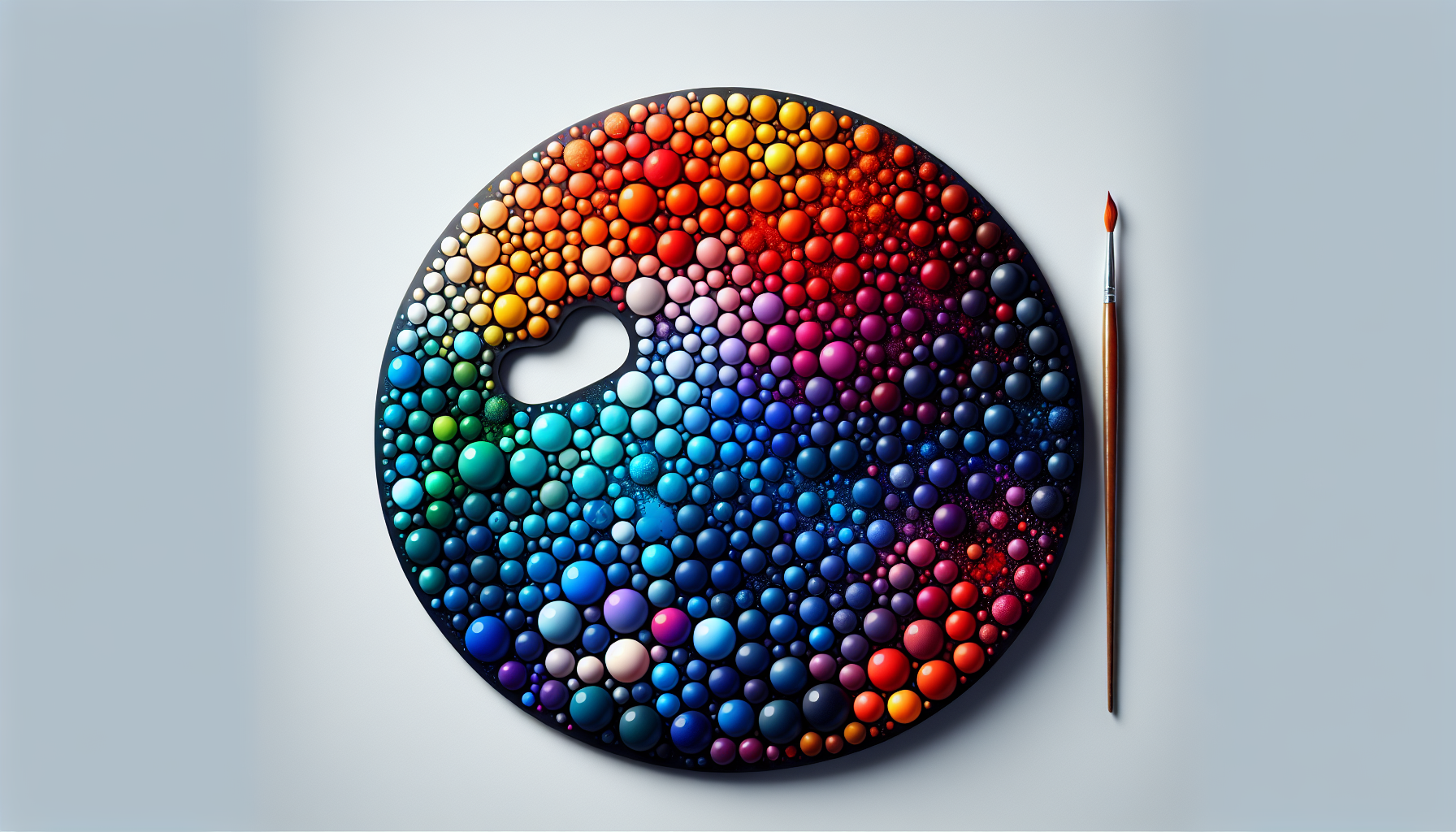Spectrum colors, encapsulated by ‘Roy G Biv’, make up the visible light range our eyes can detect—ranging from red to violet. This article examines how these colors correspond with the familiar sequence in the light spectrum, highlighting their influence on perception and daily life without delving into too much technical complexity.
Key Takeaways
- The visible light spectrum is the portion of the electromagnetic spectrum visible to the human eye, spanning wavelengths from 380 to 700 nanometers and includes the colors red, orange, yellow, green, blue, indigo, and violet, each corresponding to specific wavelength ranges.
- Spectral colors play a significant role in cultural and psychological contexts, with each color carrying multiple meanings across different societies and having strategic applications in marketing, branding, and design to evoke specific emotions and behaviors.
- Advancements in color-related technologies and scientific methods, such as OLED displays and spectroscopy, have led to their use in diverse applications ranging from enhanced visual displays to non-invasive medical diagnostics, highlighting the importance of colors beyond aesthetic aspects.
Understanding the Visible Light Spectrum

The visible light spectrum, also known as the optical spectrum, is the only segment of the broader electromagnetic spectrum perceivable by the human eye, ranging from wavelengths of 380 to 700 nanometers. This visible range, a part of electromagnetic radiation, bridges the gap between infrared and ultraviolet light, which have longer and shorter wavelengths, respectively. The spectrum encompasses an array of colors from violet, with shorter wavelengths, to red, with the longest wavelengths. Within this range, a narrow band of colors can be remembered by the mnemonic ‘Roy G Biv’, which represents the colors:
- Red
- Orange
- Yellow
- Green
- Blue
- Indigo
- Violet
Isaac Newton pioneered the discovery of the visible color spectrum, using a prism to illustrate that white light bends and disperses into the colors of the spectrum, each refracting at a unique angle. This simple experiment not only explained the science behind rainbows but also laid the foundation for our understanding of visible light and color perception.
Wavelengths and Color Perception
Wavelengths are fundamental to our perception of color as each color corresponds to a specific wavelength range within the visible spectrum. For instance, violet light ranges from 380 to 450 nanometers, while red light ranges from 625 to 750 nanometers. This might lead us to think that our perception of colors is linear with the wavelengths, but that’s not the case.
The sensitivity of our eyes to changes in wavelengths varies across the spectrum. For instance, we can detect a change as small as 1 nm around the blue-green and yellow wavelengths, while on the red and blue ends of the spectrum, the noticeable difference can exceed 10 nm. This sensitivity plays a key role in how we perceive and differentiate colors, adding an extra layer of complexity to our color vision.
White Light and Its Components
White light, an everyday phenomenon we often take for granted, is a fascinating wonder of nature. Contrary to its seemingly colorless appearance, white light contains all colors of the visible spectrum. When combined, these colors are perceived as ‘white’. This blend of colors can be separated into its constituent colors through refraction. Each color bends at its unique angle when passed through a prism, resulting in the familiar rainbow of spectral colors from red to violet.
Rainbows serve as natural demonstrations of spectral colors, visible when white light is dispersed through raindrops, similar to prism refraction. So, the next time you marvel at a rainbow, remember that it’s a beautiful display of the components of white light!
Spectral Colors and Their Significance

Having grasped the basics of the visible light spectrum, we can now explore the significance of spectral colors. Beyond their physical properties, colors hold an array of cultural and psychological associations. They are woven into the fabric of our societies, shaping our language, symbols, and emotions. In this context, understanding the role of each spectral color within the visible light spectrum becomes crucial.
For instance, the color red, known for its bold and attention-grabbing nature, is associated with strong emotions such as:
- excitement
- love
- romance
- sacrifice
- danger
The cultural meanings of red vary greatly across the world. In the West, red often symbolizes love and danger, while in Eastern cultures like China, it signifies prosperity and happiness.
Pure Spectral Colors
Within the broad range of colors that our eyes can perceive, there are pure spectral colors or colors evoked by monochromatic light. These are colors that consist of a single wavelength of light in the visible spectrum, such as:
- Red
- Orange
- Yellow
- Green
- Blue
- Indigo
- Violet
These vibrant hues are often seen in a rainbow.
Interestingly, not all perceived colors exist within the visible spectrum. Non-spectral colors like purple and magenta, although not present in the spectrum, are perceived by our brains as mixtures or bridging elements between spectral colors, such as red and violet. These colors, despite not being pure spectral colors, play a significant role in our color perception and are widely used in consumer color spaces like sRGB.
Symbolism and Cultural Associations
Each color in the spectrum carries a myriad of meanings. Here are some examples:
- Yellow, a color associated with sunlight and optimism in the West, signifies royalty in China and life and death in Mexico.
- Green, globally recognized for its connection to nature, is also associated with jealousy in some cultures.
- Blue, often seen as a calming color, can represent sadness or mourning in certain cultures.
Even colors that seem universally understood can have contrasting implications across different cultures.
These cultural associations are not just fascinating but also highly strategic. Marketers tap into color symbolism to reflect emotions and concepts, strategically using it to influence customer perceptions and behavior. As such, the spectrum of colors is inherently tied to a range of ideas and emotions in different contexts.
The Science Behind Color Vision

Having delved into the cultural significance of colors, we can now shift our focus to the scientific aspects of how we perceive these colors. Our ability to perceive color begins when light hits the retina of our eyes, which contains light-sensitive cells called rods and cones.
Rods are sensitive to low light and are more involved in transmitting black-and-white information, influencing the color and acuity of peripheral vision. On the other hand, cones are concentrated at the center of the retina. They are sensitive to higher light levels and are crucial for color detection and visual clarity. Humans have three types of cone cells, each sensitive to different light wavelengths, which allows us to perceive a wide color spectrum. Thanks to this complex system, most humans can distinguish up to one million different colors.
The Human Eye and Color Detection
A trichromatic process underlies our ability to perceive color. Our eyes are equipped with three types of cones, each responding to different light wavelengths. These cones provide the brain with visual information that allows for the interpretation and naming of colors, enabling us to perceive more variations in warmer colors.
However, our color vision isn’t constant under all conditions. During daylight, our color vision is most sensitive to wavelengths around 555 nm. In low light conditions, our visual system shifts to scotopic vision, with rod cells sensitive around 500 nm, resulting in limited color detection.
Even our peripheral vision, less capable of detecting color, contributes to our perception of a colorful world, as our brain fills in colors based on expectations and past experiences.
Color Vision Variations Among Species
While our system for color detection is complex, drawing comparisons with other species is equally fascinating. Many birds, for instance, have advanced color vision, capable of perceiving five to seven types of primary colors due to additional types of cone cells in their retina. Some animals, including bees and birds, can even perceive ultraviolet light, which lies beyond the visible spectrum for humans.
Even among mammals, there’s a wide variation in color perception. Primates such as apes and chimpanzees have color vision similar to humans, but some South American monkeys have difficulty seeing red. Dogs and cats, on the other hand, generally perceive the world in pastel colors due to weaker color detection compared to humans.
These variations in color vision among species highlight the diversity of nature’s design, reminding us how differently each creature may perceive the world. With advancements in science, we continue to uncover these fascinating aspects of color perception, enriching our understanding of the world we share with other species.
Practical Applications of Spectrum Colors

Spectrum colors, apart from their roles in nature and cultural symbolism, find practical applications across a variety of fields. They are strategically employed to indicate critical functions or draw attention to particular areas. This can be seen in the use of red for medical waste and green for user interface buttons. And as stated previously, colors also play a fundamental role in marketing and branding, establishing a business’s or organization’s visual essence and identity.
Spectrum colors are also utilized in educational materials, such as textbooks, to:
- Help differentiate sections
- Enable the visualization of associations and relationships in graphical representations
- Enhance the rapid identification of features and objects by mirroring colors found in the natural world, such as in color-coded maps and real-life object recognition.
Color Harmony and Design Principles
Color harmony, a key principle of design, involves generating visually appealing color combinations, a crucial aspect of effective design. Analogous colors, for instance, are located next to each other on the color spectrum and pair colors with the same color temperature together.
Complementary colors are color pairings that are located opposite each other on the color wheel. These pairs produce a high contrast and can create vibrant color combinations. These combinations, including a warm and a cool hue, create vibrant and high-contrast color schemes.
The triadic color scheme is another strategy that is based on choosing colors that are evenly spaced around the color wheel. This creates a harmonious and balanced color combination. These principles of color harmony guide designers in creating visually appealing and effective designs.
Color Psychology and Marketing
In marketing, color psychology principles are leveraged as marketers utilize colors’ emotional and psychological effects to influence consumer behavior. The saturation and value of colors can elicit different emotional responses in viewers, which marketers strategically use in visual media.
For instance, marketers may leverage specific spectrum colors to evoke emotional responses. Some examples include:
- The color red can stimulate appetite, making it a popular choice for food and restaurant branding.
- Orange may promote energy.
- Blue can evoke trust and calm.
These strategic uses of colors influence how consumers perceive and interact with different brands and products.
Innovations and Technologies Involving Spectrum Colors

Not limited to practical applications in daily life, spectrum colors are also harnessed in innovative technologies and scientific applications. For instance, OLED technology utilizes the spectrum of visible light to create more vibrant and diverse displays. Advanced displays selectively manipulate specific spectrum colors to achieve energy efficiency and enhanced graphical representation.
Spectrum colors are also used in various scientific and industrial applications. Colorimetric analysis methods use color changes to identify or quantify substances, while spectroscopy involves measuring how much a chemical substance absorbs light, utilizing spectrum colors to determine the substance’s concentration. These applications underscore how our understanding of spectrum colors has led to advancements in various fields.
Spectroscopy and Its Applications
Spectroscopy, which utilizes spectrum colors, stands out among technologies due to its diverse applications. This technique can be used to determine the temperature of an object by analyzing the dominant wavelengths of radiated energy, revealing changes in color. In astronomy, the absorption lines in the visible-light spectrum from celestial objects serve as unique identifiers for atoms and molecules, allowing for the discovery of these objects’ properties.
Spectroscopic techniques have seen significant improvements due to advancements in optics, detection technology, and computing, enhancing performance and broadening application scopes. Innovative approaches pair vibrational spectroscopy with imaging technologies, enabling analyses at the nanoscale. The use of quantum cascade lasers and supercontinuum light sources are instrumental in progressing infrared spectroscopy applications in diagnostics.
Infrared spectroscopy has been adapted for non-invasive glucose measurements and early disease detection, signifying advances toward portable health monitoring. The advent of handheld and portable spectroscopic devices is transforming on-site field measurements and enabling specialized point-of-care uses in clinical settings. These advancements highlight the potential of spectroscopy and its applications in improving human health and expanding our understanding of the universe.
Color-Based Technologies for Accessibility
These technologies are not just practical but also empowering. They help individuals with visual impairments navigate the world more easily, and they facilitate the processing of complex information in educational and professional settings. Indeed, the strategic application of spectrum colors in technology can significantly improve accessibility and user experience, demonstrating the transformative potential of understanding and utilizing spectrum colors.
Summary
From the mesmerizing hues of a rainbow to the vibrant displays of OLED technology, the spectrum of visible light colors shapes our world in countless ways. Understanding this spectrum enhances our appreciation of nature’s splendor, deepens our insight into cultural symbolism, and empowers us to harness colors in design, marketing, and technology. As we continue to explore the complexities of spectrum colors and their numerous applications, we not only enrich our perception of the world but also unlock new possibilities for innovation and discovery.
Frequently Asked Questions
What are 7 color spectrums?
There are seven colors in a spectrum: red, orange, yellow, green, blue, indigo, and violet, as noted by Sir Isaac Newton. This sequence of colors in a rainbow remains consistent.
What is the order of the color spectrum?
The order of the color spectrum, from lowest to highest frequency, is red, orange, yellow, green, blue, indigo, and violet. This order is reversed in terms of wavelength.
What is the meaning of spectral light?
The meaning of spectral light is the range of wavelengths of electromagnetic radiation that our eyes are sensitive to, or a plot of the intensity of light versus its wavelength.
How do our eyes perceive color?
Our eyes perceive color through a trichromatic process, where three types of cones in our eyes respond to different wavelengths of light, providing visual information to the brain. This allows us to perceive and differentiate various colors.
Do all creatures perceive colors the same way as humans do?
No, color vision varies among species, and some animals, like birds, can perceive more primary colors and even ultraviolet light, which humans cannot see.








